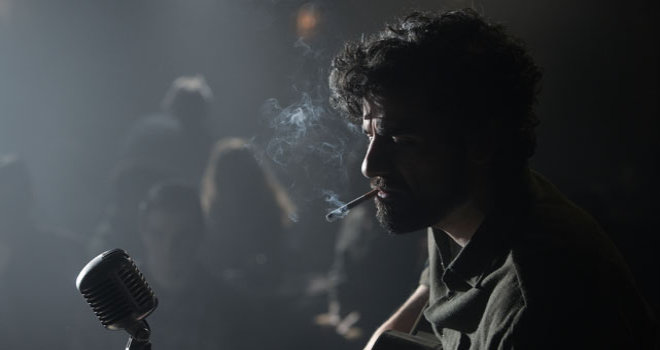Coen Bros: Inside Llewyn Davis part 1
As this excellent film has just started its run in theaters, let the reader beware: spoiler alert.
Before we meet Llewyn Davis, we get a title card; “The Gaslight Cafe, 1961.” The location and date are important. The Gaslight Cafe was one of the hubs of the folk-music revival scene in Greenwich Village in the late 1950s-early 1960s. That scene is primarily known today for producing Bob Dylan, the most brazenly talented American songwriter of his generation. Dylan is an important shadow cast over the narrative of Llewyn Davis, but, more important, the whole Macdougal Street scene and its attendant joys, sorrows and contradictions, inform the shape of the narrative, which I’ll do my best to discuss as we move forward.
So we meet Llewyn onstage at the Gaslight, singing a song onstage. The song is “Hang Me, Oh Hang Me,” by Dave Van Ronk. Now, the reader should be aware, that when a song like this is “by” someone, in this venue, what that generally means is that the singer-songwriter has built on a much older song, sometimes a song that has been through a dozen previous permutations. In the case of “Hang Me, Oh Hang Me,” it’s based on a much older song called “I’ve Been All Around This World.” The point I want to make here is that “Hang Me, Oh Hang Me, at first glance, as sung by the bearded hipster Llewyn Davis with no introduction, seems a little bit pretentious. Is this guy, the viewer wonders, really equating himself with a condemned man? “Poor boy,” he croons in the refrain, implying that his hanging is unjust, that he’s been persecuted by a big monolithic political machine. The point of this stance, in its time, was to connect the sophisticated hipsters of the gritty city to the darker corners of ancient American life. There was, and is in this scene, an air of disingenuousness: what could someone like Llewyn know about the troubles of the unjustly-persecuted rural poor from a hundred years or more before? There has always been the air of the worship of the “noble savage” in the stance of the modern folk singer: all those songs about working the land, wandering the back roads, being hunted and wronged, cruel judges and princes and queens. The singer always seems so far removed from the situation. The folk singers of the Gaslight in 1961 were trying to revive and re-define a deep strain of Americana. In a way, the narrative of Llewyn Davis asks “Does Llewyn deserve to sing these songs?” That is, is he really the “poor boy” he claims to be, or is he a pretentious hipster?
(In some ways, Llewyn is a saddened sequel to O Brother Where Art Thou?. That movie was about these exact same songs, revived just thirty years earlier, at a time when the preservation of Americana was a pressing concern. O Brother was about the “Old, Weird America,” an America before global consumerism kicked in, when there were still pockets of “real people” to be found. Llewyn takes those same songs and places them at another crossroads, at the point where they were about to explode into the popular consciousness, just when they were about to become mass culture, consumer products. In some ways, the Greenwich Village folk scene succeeded well beyond its intentions: it took the songs of the people and handed them over to the corporations.)

I know The Gaslight Cafe was a real place, but while watching the film, I connected it to the expression ‘gaslighting,’ and the idea of putting on a deception. It seemed appropriate to the possibility that Llewyn is deluding himself by continuing to be a musician.
Names are always important to the Coen Bros. And the names of the clubs are important here too, as we shall see.
Because yes, Llewyn could have just as easily performed at, for instance, Cafe Wha?, which would have provoked a whole different question.
Another nod and call back to “O Brother” is naming the cat Ulysses. Made a kind of ineffable sense as the Coens are also engaging in myth making rather than history… The Gaslight was a small unlicensed/illegal venue, not the big cave it’s made out to be and there are certainly no back allies on McDougal.
Llewyn may have been deceiving himself about his commercial potential but to my ears he sounded pretty good and way better than the arch performance given by the Army PFC who was signed by the F Murray Abraham character. (Seems all the acts in the film had a reaching quality, of being slightly less than “authentic”, in a couple of cases comically so )
Thing is, the vast majority of the people never would have heard any of this kind of music if Dylan, Peter Paul and Mary, Joan Baez etc and the corporate music industry had not found each other. You can say the same thing about Punk rock.
For a good read on the scene in those days check out “All Hopped Up and Ready to Go” by Tony Fletcher
Or the Blues.
Thanks for the insight on the Gaslight, Robert! I was curious about that myself. Since this is the second time it’s shown up in a Coen Bros movie. And then I think it was on an episode of Mad Men, too. I couldn’t find any images of it online.
Oh, but it was real, alright… I’ve been hearing about it since I was 12 (1965). Just because there are “no images of it online”… not everything is a metaphor. Some things actually happened.
Oh, I’m well aware that it was a real place. I’ve been hearing about it all my life. I was just surprised that there are so few images of its interior online, given its importance in the scheme of American music history.